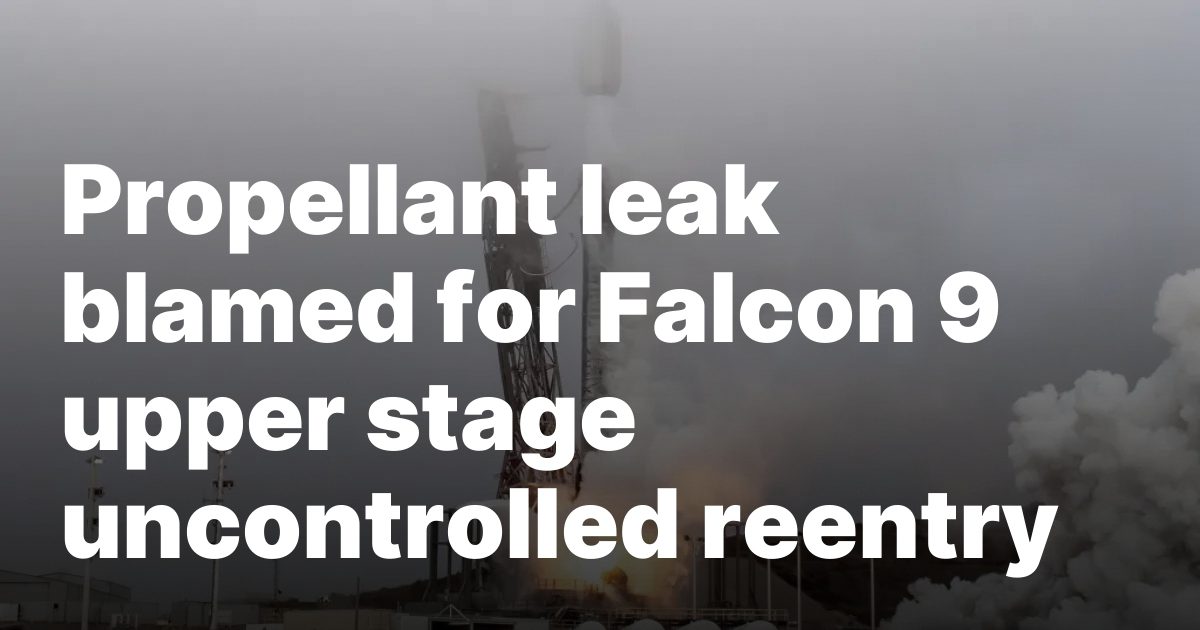
WASHINGTON — SpaceX reported that a Falcon 9 upper stage reentered the Earth’s atmosphere over Europe earlier this week, experiencing a propellant leak that hindered its ability to execute a controlled reentry.
This upper stage was launched into orbit on February 1 from Vandenberg Space Force Base in California, where it successfully deployed 22 Starlink satellites as part of the Group 11-4 mission. Following payload deployment, the stage was scheduled to perform a burn to facilitate a controlled reentry over the ocean, a standard practice for most Falcon 9 missions to low Earth orbit.
However, tracking data from the U.S. Space Force indicated that the upper stage failed to conduct the required burn and continued to orbit before its demise. The orbit decayed due to atmospheric drag, leading to its reentry early on February 19 (local time) over Europe. Fragments from the upper stage, including composite overwrapped pressure vessels, landed in Poland, near the city of Poznań.
The debris caused negligible damage, with only minor issues reported, such as a broken light fixture. A local farmer told Polish television that he intends to seek compensation for a crater left in his field by one of the tanks.
In a statement, SpaceX confirmed the inability of the upper stage to perform its deorbit burn, attributing the incident to a liquid oxygen leak. This information was later added to the mission’s page on the company’s website.
“During the coast phase of this Starlink mission, a small liquid oxygen leak developed, which ultimately led to higher than expected vehicle body rates,” SpaceX explained. As a precaution, the company passivated the upper stage by eliminating potential energy sources that could lead to fragmentation, a process typically involving the venting of propellant tanks and the discharging of batteries.
This marks the third occurrence involving a Falcon 9 upper stage in just over six months. Back in July 2024, another Falcon 9 launch of Starlink satellites experienced a liquid oxygen leak, preventing the upper stage from conducting a necessary circularization burn. While the Starlink satellites were deployed, excessive atmospheric drag led to their premature reentry.
Investigations revealed that a liquid oxygen leak caused ice to accumulate on the Merlin engine of the upper stage, which resulted in excessive cooling of engine components and a challenging start for its second burn. Falcon 9 missions resumed just 15 days following that incident.
A second anomaly occurred during the launch of the Crew-9 mission to the International Space Station in September. SpaceX noted that there was an “off-nominal deorbit burn,” leading the upper stage to reenter outside the planned zone in the South Pacific Ocean. This incident also prompted SpaceX to halt Falcon 9 launches temporarily for further investigation.
Subsequently, the Federal Aviation Administration approved the resumption of Falcon 9 launches nearly two weeks later, granting a waiver for one Falcon 9 launch related to the Hera asteroid mission, which did not include a deorbit burn.
Alongside these incidents, a failed landing of a Falcon 9 booster in August garnered the attention of NASA’s Aerospace Safety Advisory Panel. Kent Rominger, a former astronaut and panel member, remarked on October 31 that the recent incidents highlight the necessity for meticulous attention to detail as equipment ages and launch frequency increases.
Notably, only the July incident resulted in a mission failure, while both the Crew-9 Crew Dragon spacecraft and the Starlink satellites launched on February 1 were successfully deployed despite the upper stage’s deorbiting issues. The latest event did not lead to a significant halt in SpaceX’s launch schedule.
“Our teams are actively investigating the root cause of the leak and have already implemented measures for future flights,” SpaceX stated on its website, though additional details regarding these measures remain undisclosed.
Related









